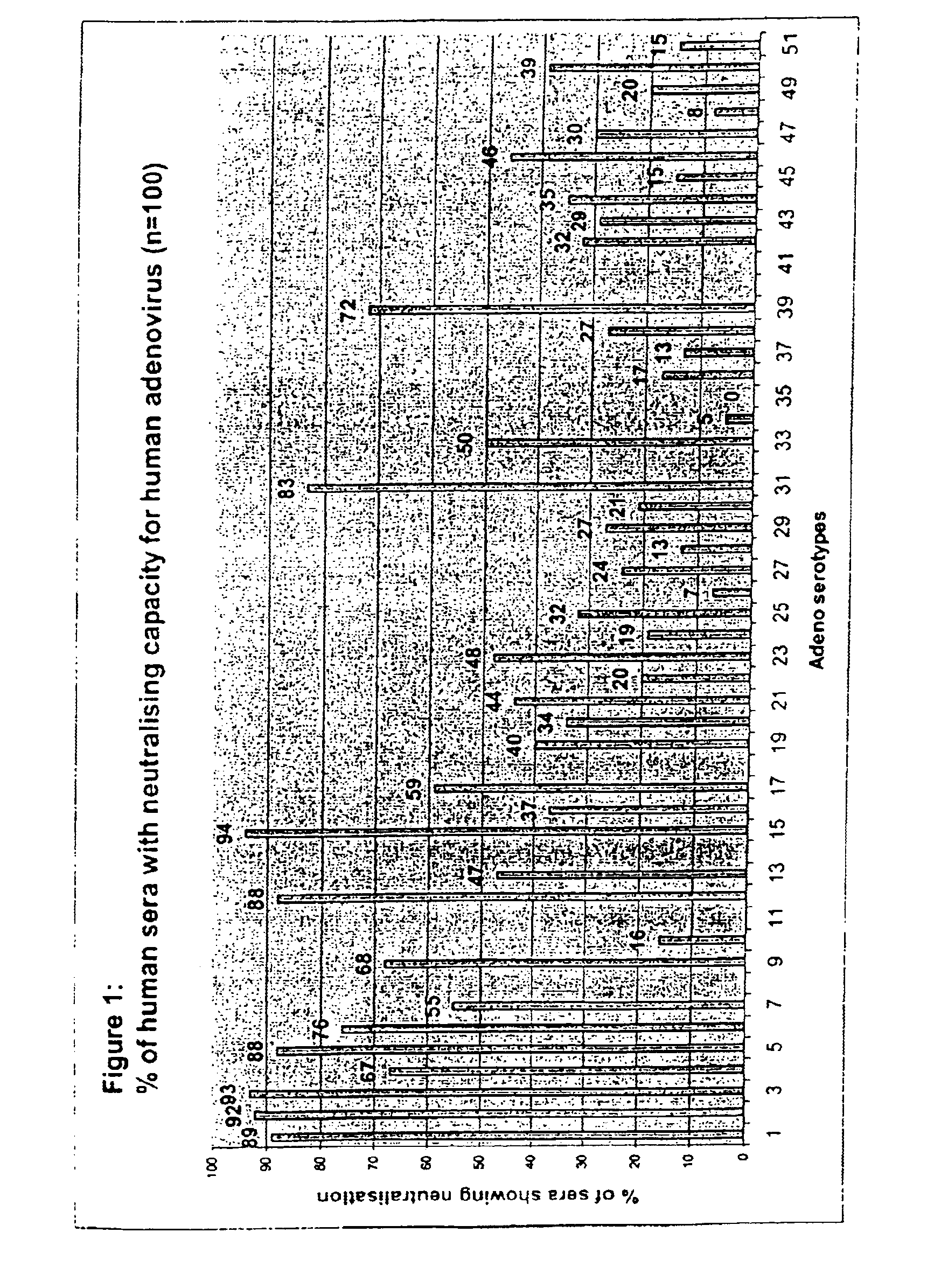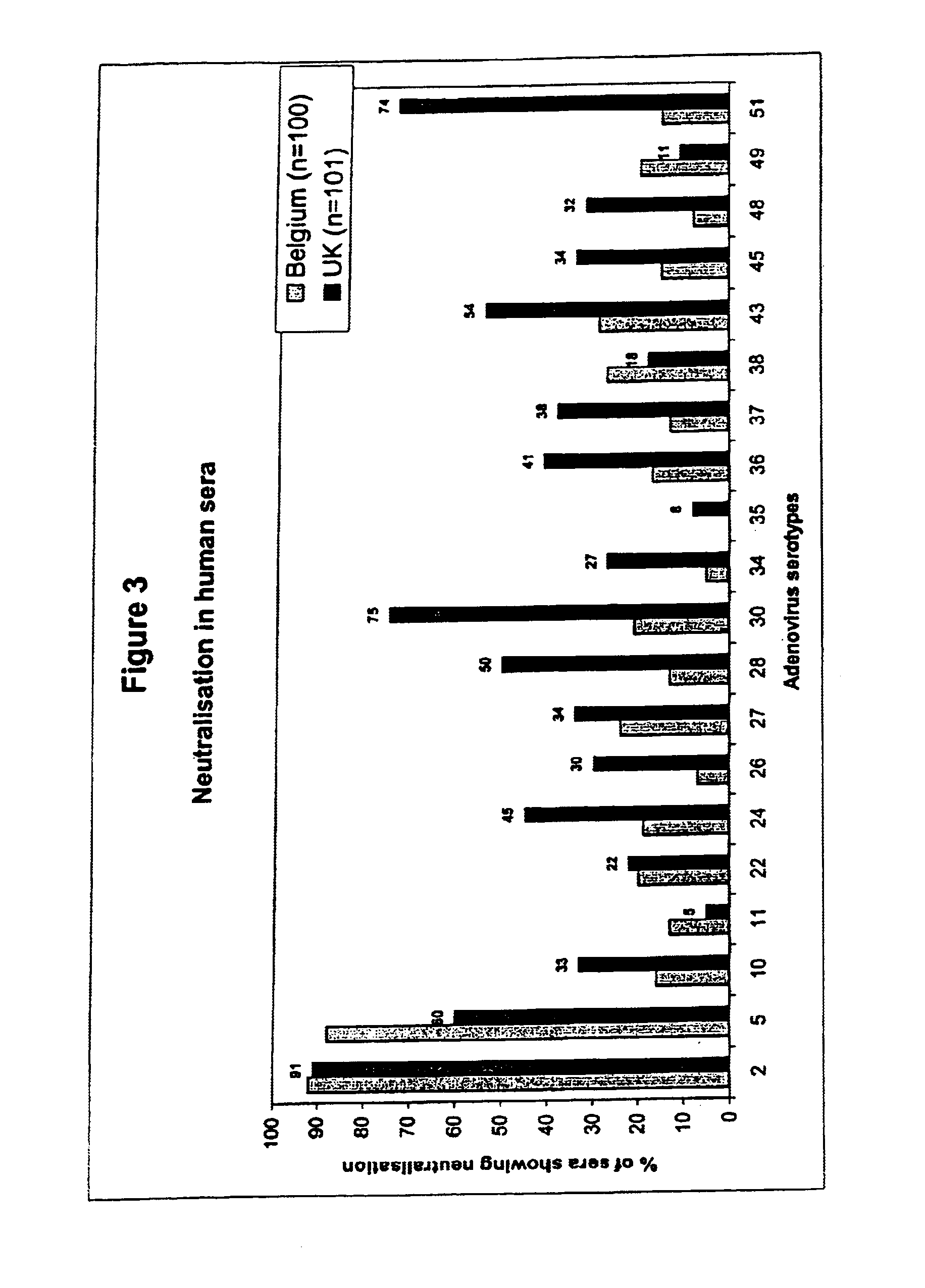Complementing cell lines
a technology of complementing cell lines and adenoviruses, applied in the field of biotechnology, can solve the problems of generating and propagating adenoviruses from other serotypes, like subgroup b viruses, and is more difficult on per.c6 cells
- Summary
- Abstract
- Description
- Claims
- Application Information
AI Technical Summary
Benefits of technology
Problems solved by technology
Method used
Image
Examples
example 1
A High Throughtput Assay for the Detection of Neutralizing Activity in Human Serum
[0066]To enable screening of a large amount of human sera for the presence of neutralizing antibodies against all adenovirus serotypes, an automated 96-wells assay was developed.
Human Sera
[0067]A panel of 100 individuals was selected. Volunteers (50% male, 50% female) were healthy individuals between ages 20 and 60 year old with no restriction for race. All volunteers signed an informed consent form. People professionally involved in adenovirus research were excluded.
[0068]Approximately 60 ml blood was drawn in dry tubes. Within two hours after sampling, the blood was centrifuged at 2500 rpm for 10 minutes. Approximately 30 ml serum was transferred to polypropylene tubes and stored frozen at −20° C. until further use.
[0069]Serum was thawed and heet-inactivate at 56° C. for 10 minutes and then aliquoted to prevent repeated cycles of freeze / thawing. Part was used to make five steps of twofold dilutions i...
example 2
The Prevalence of Neutralizing Activity (NA) to Ad35 is Low in Human Sera from Different Geographic Locations
[0081]In Example 1, the analysis of neutralizing activity (“NA”) in human sera from one location in Belgium was described. Strikingly, of a panel of 44 adenovirus serotypes tested, one serotype, Ad35, was not neutralized in any of the 100 sera assayed. In addition, a few serotypes, Ad26, Ad34 and Ad48 were found to be neural in 8%, or less, of the sera tested. This analysis was further extended to other serotypes of adenovirus not previously tested and, using a selection of serotypes from the first screen, was also extended to sera from different geographic locations.
[0082]Hereto, adenoviruses were propagated, purified and tested for neutralization in the CPE-inhibition assay as described in Example 1. Using the sera from the same batch as in Example 1, adenovirus serotypes 7B, 11, 14, 18 and 44 / 1876 were tested for neutralization. These viruses were found to be neutralized i...
example 3
Sequence of the Human Adenovirus Type 35
[0088]Ad35 viruses were propagated on PER.C6 cells and DNA was isolated as follows: To 100 μl of virus stock (Ad35: 3.26×1012 VP / ml), 10 μl 10×DNAse buffer (130 mM Tris-HCl pH7.5; 1,2 M CaCl2; 50 mM MgCl2) was added. After addition of 10 μl 10 mgr / ml DNAse I (Roche Diagnostics), the mixture was incubated for 1 hr. at 37° C. Following addition of 2.5 μl 0.5M EDTA, 3.2 μl 20% SDS and 1.5 μl ProteinaseK (Roche Diagnostics; 20 mgr / ml), samples were incubated at 5° C. for 1 hr. Next, the viral DNA was isolated wing the GENECLEAN spin kit (Bio101 Inc.) according to the manufacturer's instructions. DNA was eluted from the spin column with 25 μl sterile MilliQ water. The total sequence was generated by Qiagen Sequence Services (Qiagen GmbH, Germany). Total viral DNA was sheared by sonification and the ends of the DNA were made blunt by T4 DNA polymerase. Sheared blunt fragments were size fractionated on agarose gels and gel slices corresponding to DNA...
PUM
| Property | Measurement | Unit |
|---|---|---|
| pH | aaaaa | aaaaa |
| volume | aaaaa | aaaaa |
| volume | aaaaa | aaaaa |
Abstract
Description
Claims
Application Information
 Login to View More
Login to View More - R&D
- Intellectual Property
- Life Sciences
- Materials
- Tech Scout
- Unparalleled Data Quality
- Higher Quality Content
- 60% Fewer Hallucinations
Browse by: Latest US Patents, China's latest patents, Technical Efficacy Thesaurus, Application Domain, Technology Topic, Popular Technical Reports.
© 2025 PatSnap. All rights reserved.Legal|Privacy policy|Modern Slavery Act Transparency Statement|Sitemap|About US| Contact US: help@patsnap.com



